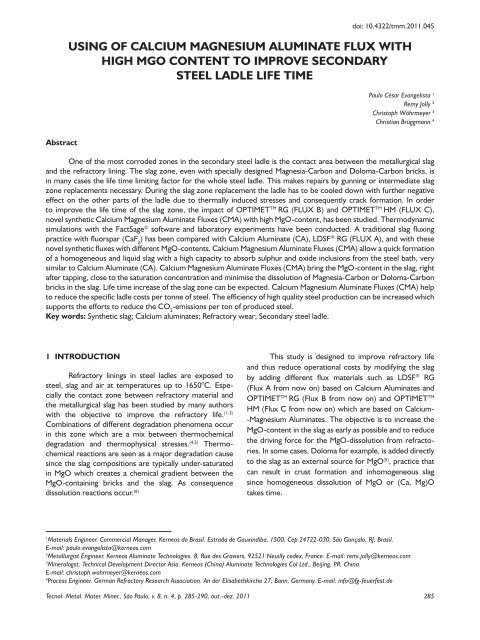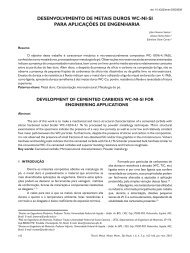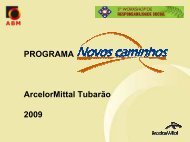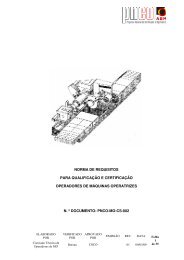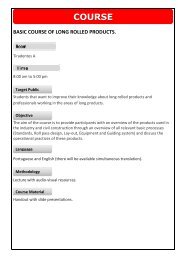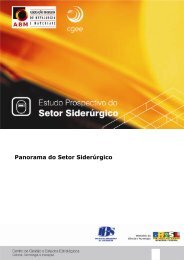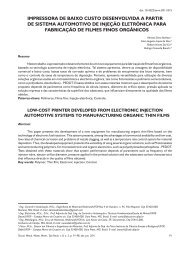Using of calcium magnesium aluminate flux with high MGO ... - ABM
Using of calcium magnesium aluminate flux with high MGO ... - ABM
Using of calcium magnesium aluminate flux with high MGO ... - ABM
- No tags were found...
Create successful ePaper yourself
Turn your PDF publications into a flip-book with our unique Google optimized e-Paper software.
Evangelista et al.chemical composition <strong>of</strong> the slag as a result <strong>of</strong> the refractorycorrosion. During the short slag sampling process, theslag surface was exposed to normal air. Slag samples wereanalysed by semi-quantitative XRF.3 RESULTS3.1 Magnesia-C Brick in Contact <strong>with</strong> Slag fromAl-killed SteelSome <strong>of</strong> the different slag practices that have beentested are shown in Table 3 <strong>with</strong> their initial composition(liquid part <strong>of</strong> the slag after 1 minute <strong>of</strong> Flux addition).The values are average analyses from the first 2 (in somecases 3) heats. The theoretical MgO-saturation has beencalculated from Equation 2 for 1600°C. As can be seenin Figure 2, Calcium Magnesium Aluminate Flux createsrapidly a liquid slag (e.g. slag A-2) in which the total MgOconcentration is increased by 2% compared to Flux A(slag C) at an addition rate <strong>of</strong> 20%. Almost all MgO isalready after 1 minute inside the liquid phase while incase <strong>of</strong> slag B practically none <strong>of</strong> the added MgO has beentransferred into liquid at this stage. Based on the average<strong>of</strong> the inner diameter <strong>of</strong> the eight MgO-C segments duringone run, it becomes obvious that CaF 2creates the strongestcorrosion (Figure 3).FLUX A represents an improvement compared toCaF 2. Significantly better is the use <strong>of</strong> FLUX B and FLUX Cwhich causes by far the lowest corrosion. In case <strong>of</strong> theslag practice <strong>with</strong> FLUX B a <strong>high</strong> initial MgO level couldbe achieved (Figure 4) and consequently only a small MgOcontent increasing has been observed after 30 minuteswhich is related <strong>with</strong> the low corrosion rate. With FLUX Cthe initial MgO content in the slag reaches very early theMgO saturation limit (Figure 5) which explains the verylow corrosion rate when FLUX C is employed. The mostsignificant increase in MgO was observed <strong>with</strong> the CaF 2practice which explains the strongest corrosion in thatcase. On the other hand a FLUX A practice shows a similarMgO dissolution but a lower corrosion rate. Here it has tobe mentioned that the corrosion pr<strong>of</strong>ile in case <strong>of</strong> CaF 2isdifferent due to the low slag viscosity which more stronglyattacks the bonds <strong>of</strong> the MgO-C brick. As consequenceMgO grains from the brick can more easily be removedfrom the brick structure by mechanical movements <strong>of</strong> theslag. (7)Figure 4. Measured initial MgO content in slag and after 30 minutestreatment time versus MgO-C corrosion rate.Figure 2. Fluxing behaviour <strong>of</strong> FLUX A (slag C; left) and FLUX B(slag A-2; right) at 1600°C.Figure 5. Evolution <strong>of</strong> MgO content in slag in contact <strong>with</strong> MgO-Cbricks as function <strong>of</strong> <strong>flux</strong> material.Figure 3. MgO/C-brick corrosion rate <strong>with</strong> different slags.These MgO grains can float as solid particles inthe slag when slag becomes saturated <strong>with</strong> MgO. Duringslag sampling <strong>with</strong> a steel rode, solid grains attached to288 Tecnol. Metal. Mater. Miner., São Paulo, v. 8, n. 4, p. 285-290, out.-dez. 2011
<strong>Using</strong> <strong>of</strong> <strong>calcium</strong> <strong>magnesium</strong> <strong>aluminate</strong> <strong>flux</strong> <strong>with</strong> <strong>high</strong> <strong>MGO</strong> content to improve secondary steel ladle life timeTable 4. Slag chemical composition before and after <strong>flux</strong>ing and corrosion rates <strong>of</strong> Doloma-C bricks at 1600°C (wt%)Slag E-0 Slag F Slag G Slag HSlag before <strong>flux</strong> addition Slag E-0 plus 7% FLUX C Slag E-0 plus 7% FLUX A Slag E-0 plus 3.5% CaF 2FeO 10.4 9.8 9.8 10.0CaO 56.0 54.4 55.7 54.0Al 2O 39.2 11.4 11.5 9.0SiO 220.8 19.6 19.6 20.0MgO 3.6 4.8 3.4 3.5CaF2 0.0 0.0 0.0 3.5Σ 100 100 100 100Corrosion rate (mm/h) 0.33 0.68 1.02the liquid slag sample were observed. This phenomenaexplains why the MgO content after 30 minutes was closeto 7% in all cases, corresponding to the MgO saturationlimit. Although FLUX B and FLUX A + MgO bring theoreticallythe same total amount <strong>of</strong> MgO in the slags A-2and B, the faster dissolution <strong>of</strong> MgO in Calcium MagnesiumAluminate Flux creates an advantage over an externalMgO addition. Due to the slow dissolution rate <strong>of</strong> theadded MgO grains corrosion is consequently strongerthan in case <strong>of</strong> Calcium Magnesium Aluminate Flux. Chen,Brooks and Nightingale (1) observed that a dense MgOgrain <strong>of</strong> 20 mm in diameter attacked in different slags isloosing only between 0.6 mm and 2.2 mm <strong>of</strong> its diameterin 15 minutes.It has also been tested how a reduced additionrate <strong>of</strong> Calcium Magnesium Aluminate Flux behaves. Byadding only 10% <strong>of</strong> FLUX B thus approximately 1% MgOthe corrosion was found in the same range as <strong>with</strong> slag B<strong>with</strong> 20% FLUX A + 2% MgO. This indicates again thatthe MgO from the Calcium Magnesium Aluminate grainsdissolves more rapidly in the slag than the externally addedMgO-grains.3.2 Dolomag-C Brick in Contact <strong>with</strong> Slag fromSi-killed SteelSimilar positive effects on refractory life time havebeen found when Calcium Magnesium Aluminate is usedas metallurgical <strong>flux</strong> for Si-killed ladle slags in contact <strong>with</strong>Dolomag-C bricks. While CaF 2<strong>flux</strong> caused a corrosionrate <strong>of</strong> 1 mm/h it could be reduced by the use <strong>of</strong> FLUX Adown to 0.7 mm/h and even to 0.3 mm/h when FLUX Cwas used as metallurgical <strong>flux</strong>. (11) The different slag practicesthat have been tested are shown in Table 4.Calcium Magnesium Aluminate Flux compared to FLUX Aimproves the refractory life <strong>of</strong> the slag zone due to thefast gap closing between the initial MgO and the saturationconcentration in the slag. This gives an advantage over theseparate addition <strong>of</strong> Magnesia or Doloma as MgO source.Compared to CaF 2-practices an improvement <strong>of</strong> 25%and compared to a FLUX A practice <strong>of</strong> 15% has beenmeasured in laboratory tests <strong>with</strong> Magnesia-Carbon brickswhen FLUX B is used. FLUX C brings further significantimprovements <strong>of</strong> the slag zone durability both in case<strong>of</strong> Magnesia-C and Doloma-C bricks. Based on simulations<strong>with</strong> the FactSage © s<strong>of</strong>tware a simplified calculationequation has been proposed which allows very rapidly toestimate the real gap between initial MgO content in themetallurgical slag and the saturation concentration. Thishelps to select the most adapted Calcium MagnesiumAluminate Flux version for each steel ladle configurationand to adjust the necessary amount <strong>of</strong> <strong>flux</strong> additionin an easy and economical way. By applying the syntheticCalcium Magnesium Aluminate Flux in the secondary steelladle process a significant reduction in specific productioncosts via the reduction <strong>of</strong> the specific refractory consumptionper ton <strong>of</strong> steel can be expected. First results fromlarge scale trials in steel ladles have confirmed this positivetrend. The metallurgical efficiency <strong>of</strong> Calcium MagnesiumAluminate Flux enables to achieve rapidly the targeted<strong>high</strong> quality steel composition. This rapidity helps to safeenergy in the steel production process. The reducedspecific refractory consumption helps to save resources.All together Calcium Magnesium Aluminate Flux supportsthe efforts to reduce specific CO 2emissions per ton <strong>of</strong>produced steel.4 SUMMARY AND OUTLOOKCalcium Magnesium Aluminate Flux additions tosteel ladle slags allow a quick formation <strong>of</strong> a homogeneousliquid metallurgical slag <strong>with</strong> a <strong>high</strong> initial MgO-content.The elevated and microcrystalline MgO content insideAcknowledgementWe would like to thank the team <strong>of</strong> the GermanRefractory Research Association (FGF), for the fruitfuldiscussions, and the DIFK GmbH for conducting the thermodynamicsimulations and the practical experiments.Tecnol. Metal. Mater. Miner., São Paulo, v. 8, n. 4, p. 285-290, out.-dez. 2011 289
Evangelista et al.REFERENCES1 CHEN, Y.; BROOKS, G. A.; IGHTINGALE SA. Slag line dissolution <strong>of</strong> MgO refractory. Canadian MetallurgicalQuarterly, v. 44, n. 3, p. 323-30, 2005.2 JANSSON, S.; BRABIE, V.; BOHLIN, L. Corrosion mechanism and kinetic behaviour <strong>of</strong> refractory materials incontact <strong>with</strong> CaO-Al 2O 3-MgO-SiO 2slags. In: INTERNATIONAL CONFERENCE ON MOLTEN SLAGS FLUXESAND SALTS, 7., 2004, Cape Town, South Africa. Proceedings... Marshalltown: The South African Institute <strong>of</strong> Miningand Metallurgy, 2004. p. 341-7.3 AKKURT, S.; LEIGH, H. D. Corrosion <strong>of</strong> MgO-C ladle refractories. American Ceramic Society. Bulletin, v. 82, n. 5,p. 32-40, 2003.4 POIRIER, J. et al. An overview <strong>of</strong> refractory corrosion: observations, mechanisms and thermodynamic modeling.Refractories Applications Transactions, v. 3, n. 2, p. 2-12, 2007.5 BLUMENFELD, P.; PERUZZI, S.; PUILLET, M. Recent improvements in Arcelor steel ladles through optimization <strong>of</strong>refractory materials, steel shell and service conditions. La Revue de Métallurgie-CIT, v. 102, n. 3, p. 233-9, Mar. 2005.6 REISINGER, P. et al. MgO-Löslichkeit in Stahlwerksschlacken. Berg-und Hüttenmännische Monatshefte, v. 144, n. 5,p. 196-203, 1999.7 HARATIAN, M.; MARANDIAN, M.; ABOUMAHBOUB. A. The effect <strong>of</strong> synthetic slag usage on ladle refractory life.In: INTERNATIONAL COLLOQUIUM ON REFRACTOREIS, 47., 2004, Aachen. Proceedings... Warrendale, PA:Association for Iron & Steel Technology, 2004. p. 144-7.8 OLVIRA, F. C. et al. The use <strong>of</strong> prefused slags in the manufacture <strong>of</strong> ultra-clean steel in TAMSA. In: SIMPOSIONACIONAL DE SIDERURGIA, 18., Mexico, 1996.9 LACHMUND, H. et al. Cost effectiveness <strong>of</strong> DH slag treatment <strong>with</strong> optimized metallurgical results. La Revue deMetallurgie – ATS – JSI, v. 104, n. 10, p. 164-5, Oct. 2007.10 THERMFACT AND GTT-TECHNOLOGIES. FactSage © . Available from: .Cited: 2010 Feb. 2011 WÖHRMEYER, C.; JOLLY, R.; BRÜGGMANN, C. Novel <strong>flux</strong>ing agent for slags in secondary steel ladles to improverefractory life time and steel quality. In: CZECH METALLURGICAL CONFERENCE, 26, 2010, Roznov podRadhostem. Czech RepublicTechnical University Ostrava, 2010. p. 72-6.Recebido em: 15/10/2010Aceito em: 26/10/2011290 Tecnol. Metal. Mater. Miner., São Paulo, v. 8, n. 4, p. 285-290, out.-dez. 2011


